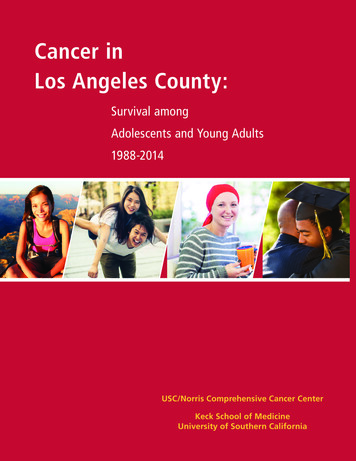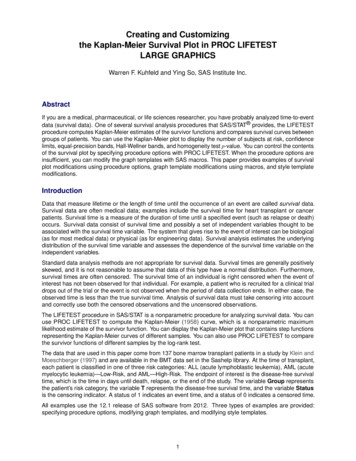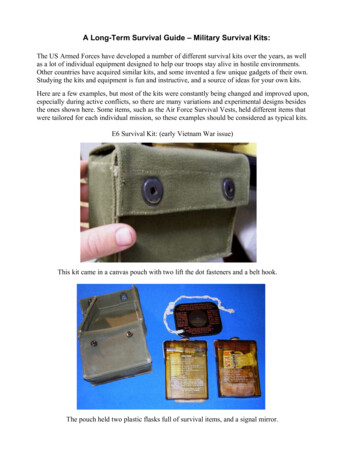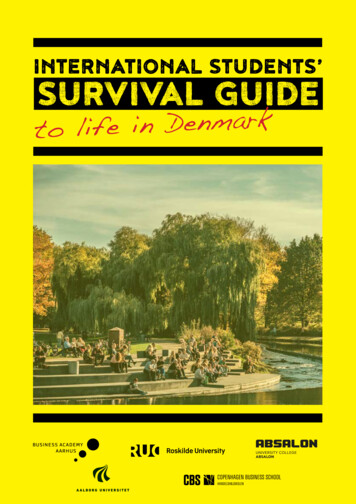
Transcription
AFSNIT 2INTERNATIONAL STUDENTS’SURVIVAL GUIDEkramneDniefilto
Made by The Cooperative of Danish Student Unions (Elev- og Studenterkooperativet) in collaboration with the NationalUnion of Students in Denmark (Danske Studerendes Fællesråd).First edition author: Stine AgerbækContributors: Lena K. Hansen, Natasha Jessen-PetersenProject manager: Marie Skjelbo JustesenPhotos:Natasha Jessen-Petersen, Vartan Epremian, Yvette Chen, Jessica Marchet, Jenny Chi, Rodrigo Bosch, Matteo Oppo,Humbug, Thomas Heie Nielsen, VisitAalborg, SmartDrones Aarhus, Ungdommens Røde Kors, Danske StuderendesFællesråd, CBS Climate Club, Visit Odense.Second through sixth edition updates:The Cooperative of Danish Student Unions (Elev- og Studenterkooperativet)Sixth edition, May 2021Print: Stenby Tryk A/SPlease note: At the time of publication, all links are working. If you stumble upon a link that isn't working, please let usknow, thanks!www.dsfnet.dkwww.esknet.dkThe International Survival Guide for Students in Denmark is available and applicable to all international students in Denmark,but published specifically for international students l-degree-students
CONTENTChapter 1Chapter 504Welcome to Denmark42Housing05Culture Shock44How to Find a Place to Live46Housing Options48Furniture49How to Avoid Housing ScamsChapter 206Denmark at a Glance!09Transportation and Getting Around Town10Things to See and Do in Your University CityChapter 312Getting Started in Denmark13ICS and SIRI in Aalborg, Aarhus, Odenseand Copenhagen14 Rules and Requirements forGetting a CPR-NumberChapter 652Meeting the Danes54Meeting People56How to Get Involved58Danish Friends 60Do the Danes Even Date?61Explore Your City62Bike Culture63Nightlife as a Danish Student16Opening a Bank Account in Denmark17SU18PhonesChapter 719Internet65Getting a Student Job20Transportation66What Kind of Jobs Can You Get as a21Emergency22Healthcare67Where Do You Find a Job?23Covid-19 in Denmark68CV and cover letters24Dentists and Extra Healthcare Services69Danish Work Culture25Insurance70Unemployment Insurance Fund26Family, Children, and Pets72Unions27NEMID and Digital Denmark 73Taxes (SKAT)28Students with disabilities29What to remember, if you leave.Chapter 4Student?Chapter 875Danish History & Society76Political System31Student Life78Education32Being a Student79Danish Culture Crash Course34Practical University Info82Public Holidays in Denmark36Life Outside Uni83 Expat Blogs and Fun Sites38Do More - Spend less41Everyday SustainabilityAbout Danish Culture3
C H A P T E R 1 – W E L CO M EWELCOME TO DENMARKWELCOME! You have decided to study in Denmark, andfor that we salute you. We hope that you will enjoy yourstay. We know that acclimatising to a new country anda new city can be complicated – and we know that theDanes can be a little weird at times, so this book will giveyou tips, insights and background information on how toexperience the best possible student life in Denmark.In each chapter you will find useful information, tips andtricks, fun (and not so fun) facts about Denmark, and avariety of links and places to get even more information.This book is a guide to many different aspects of Danishstudent life. It is not comprehensive, but we have tried tocover as much ground as possible. We will give you tips,information and where-to-go places, but we will not beable to solve every problem that you encounter.We hope this book will give you the tools and theknowledge to solve your problems on your own.We believe that this will bring you further than any quickfixes could otherwise do.If you have any questions during your stay here and don’tknow where to go, our best tip is simple: Ask a Dane!Approach one of your Danish classmates and ask themhow they find their way around your university’s intranet,how they navigate the Nem-ID-system, or where theybought their bike. They know these things better thanany book ever could, and the best cultural knowledge isgained through meeting people – so ask for informationand help when needed.Before you plan your trip to Denmark, remember to checkwhether your new university offers pre-semester introduction activities and language classes. If they do, we recommend that you plan to participate in those, as these willgive you the best possible start to your stay here.We hope that you will have fun, learn a lot, and enjoy yourexperiences as a student in Denmark.!InfoFor more information about studyingat Danish universities, see below:www.studycph.dkwww.studyindenmark.dkLanguage CoursesThe majority of universities inDenmark have Danish languagecourses for internationalstudents either pre-semesteror in the beginning of thesemester. Check with yourlocal international office(or Student Hub if you arestudying at CBS) when youarrive if it’s not mentionedin your admittance package.After 1 July 2020, tuition feeson language courses will beremoved, however the depositswill be increased. If you wouldlike to continue studying Danish,there are numerous private andpublic centres offering languagecourses for internationals.Contact your local CitizenService Center or municipalityto get specific informationabout your options. Be sure toask about any potential tuitionfees or deposits that may becharged when taking continuedlanguage courses.READ MORE ree-danish-classes/4
W E L CO M E – C H A P T E R 1You’renot alone!(Even if you feel like it)Moving to a new city canCULTURE SHOCKARRIVING IN A NEW COUNTRY can result in both practical and personalissues. Some people even talk about experiencing an actual “culture shock”.Here are some tips on how to make your first time in a new culture easier andmore enjoyable.Although Denmark is a well-organised country and people here are eager tomake you feel comfortable, you will need some time to settle in. There may betimes when you question why you left home, which is likely similar to what yourfellow students are feeling.be tough. Moving to a different country and culturealtogether can be eventougher.Surveys indicate thatabout one in four of theinternational students inDenmark have experienced loneliness duringtheir stay. However, thisis not only a problem forWhen this happens, it is important for you to remember that you are goingthrough a learning process. By accepting this brief adaptation period as a learning experience, you will ultimately return home with greater self-confidenceand the skillset to succeed in a multicultural environment.So keep active, engage in social opportunities, talk to people and try to learnDanish.international students– similar surveys from2015, amongst Danishstudents, show thatabout one in six ofthem also feel lonely atuniversity.Remember: you are not alone in experiencing this. Talking about your feelingsand worries is the best way to deal with loneliness or homesickness.Students’ lonelinessmay be caused by theTip!Here are some tips on easing yourself into a new culturefrom Study in Denmark (www.studyindenmark.dk)› Accept that you cannot know everything about your new country and language› Keep an open mind› Try to do things that you did at home› Stay in touch with family and friends at home› Talk to other students about how you feel› Stay active by getting involved in nearby clubs (foreninger), or by joining asports teamfragmented universitystructure and the lack ofcentrally located socialactivities. If you want tocounter this, there aremany ways to get involvedboth at your university andin your city, and throughthe local Student House(Studenterhus). See chapter 6 for more ideas.5
CHAPTER 2 – NENZEALANDRoskildeCopenhagenDENMARK AT A GLANCE!DENMARK. Home of Hans Christian Andersen, Tivoli,LEGO, beer, pastries and hygge.On the surface it’s hard not to see Denmark as a tiny cutecountry, mostly known for its fairytales and tourist attractions unless you arrive in January. Then you’ll probablynotice the grey, rainy and cold weather, and crazy Daneswho will bike to class regardless of snowstorms and rain.Denmark is a lot of things, and we hope that you will discover a great deal of those things during your stay here.GeographyDenmark consists of the Jutland peninsula and 443named islands, linking Northern Europe and Scandinaviavia the Øresund bridge. Copenhagen, the country’s capital, is situated on the biggest island in Denmark, calledZealand. You can find Funen, a slightly smaller island,between Zealand and Jutland.The big university cities are Aalborg and Aarhus in Jutland, Odense on Funen and the Greater Copenhagenarea (including Roskilde and Lyngby) on Zealand.6Danish demographyDenmark has a population of a little over 5,8 millionpeople. Copenhagen is the biggest city with 1,3 millioninhabitants, followed by Aarhus (approx. 340.000 inhabitants), Odense (approx. 200.000) and Aalborg (117.000).Most of Denmark’s population can be described as middle class, and there is little divide between most people’sliving conditions, compared to other western countries.Around 85% of the Danish population is considered “ofDanish descent”, meaning that they have one or two Danish parents. The remaining 15% of the population is a mixof Western and Non-Western immigrants, guest workersand refugees.It is mandatory that all Danish kids receive at least nineyears of education, normally until the age of 15 or 16,resulting in a 99% literacy rate in Denmark.Government-funded education is free of charge and opento all. 60% of all Danes between the ages of 15 and 69have a higher-level education.
DENMARK – CHAPTER 2ClimateDENMARK IS SITUATED in the temperate zone, and has a coastal climate,resulting in generally mild temperatures that rarely become either too cold ortoo hot.Winters seldomly get much colder than 0 to -10 degrees Celsius.The weather tends to be mixed throughout the year in terms of sun, windand rain, but be prepared for wonderful sunny, rainy, and grey days, and thenthose days where it simply feels like you’re about to get blown away by astorm. Get a pair of rainboots, a raincoat and a big scarf, and remember thatlayers are the way to go all year round.Due to Denmark’s geographical placement, which is quite north, wehave short days in the winter (from 9-16 around winter solstice)and long days and bright nights in the summer. This results in alot of indoor cosiness (hygge) in the winter and outdoor funin the summer.Outdoor life is an important part of enjoying life inDenmark, even if it’s just biking through the cityon your way to university – so be preparedfor that. Get a bike, and pack some warmclothes that will enable you to go outsideand enjoy yourself regardless of theweather.If you don’t have winter orautumn clothes with you,several shops such asH&M, etc. haveplenty of affordableoptions.ReligionRELIGIOUS FREEDOM is a constitutional right in Denmark. The country’s officialstate religion is Christianity, in the form of the Evangelical Lutheran Church of Denmark (Dansk Folkekirke).In this respect Denmark is a non-secular state; however, atheismand most religions are represented within Danish society, and religion is rarelymentioned in political or state matters. The second largest religion is Islam, whichhas witnessed an increase since the 1980s as a result of immigration. There areJewish, Muslim and different Christian congregations in the bigger cities, socontact them, if you are interested in getting involved.Most Danes see themselves as secular in their daily lives, and churchattendance is generally low. Religion plays little role in most people’slife choices, and it can actually be seen as a social faux pas todiscuss religion at lengths with people you don’t know verywell. Most Danes prefer to keep their religious preferences private, so maybe don’t bring it up asthe first topic when meeting newpeople.7
CHAPTER 2 – DENMARK8
DENMARK – CHAPTER 2TRANSPORTATION ANDGETTING AROUND TOWNWITHIN THE CITIES, biking, walking, and taking publictransportation are more than enough to get you aroundtown.Bikes can be quite cheap, often the fastest solution (nowaiting for the bus), and most Danes will bike regardlessof rain or snow. If you have only just learned how to ridea bike upon coming to Denmark, do be careful so thatyou don’t hurt yourself. In some Danish cities, Red Crossoccasionally organises “bike schools” for foreigners whowould like to learn.If you know how to ride a bike, find an affordable yet reliable one (ask your classmates where they bought theirs,or check various Facebook groups where you can buy aused one), and remember to be safe while using it.Signal when you turn and when you stop, stop for redlights and you should always (always) stay in the bikelane or as far right on the road as is safely possible.Remember to get lights for your bike (white for thefront, red for the back) to use at night, and to not bikeon sidewalks or through pedestrian crossings.It is not mandatory to wear a helmet in Denmark, butkeep your brain safe and get a proper one that fits youand has the CE certificate (a sticker inside the helmetwith CE, stating that it’s approved). It can save your life.For safety reasons, we recommend that you do notlisten to loud music, and know that the use of yourmobile phone while biking is illegal.E-scooters have also become quite a thing in major Danishcities. These are great for a quick trip, but can add up andbe a bit expensive. Use the various e-scooters with caution as they can be tricky to handle.In the bigger cities, busses, metros, and local trains are allgood reliable options for transportation. In Aarhus, you alsohave the Light Rail, which is a great alternative to othermeans of transportation.Across Denmark, there are trains (check out DSB’s ”Orange”tickets), ferries, and coach services that you can take. Trainlines run between the different regions.You must have a valid ticket or commuter card whenusing public transportation, as the fines for riding withoutone are high in all cities.Outside the cities people often travel by car, and mostfamilies have at least one. It is expensive to own a car inDenmark due to high car taxes, high fuel prices, and highinsurance costs, so few students own one. But there areservices which allow cheap car rental and car-pooling likeGoMore.The app ”Rejseplanen” is a great tool to plan your trip, andprovide you with an overview of public transport options.9
CHAPTER 2 – DENMARKTHINGS TO SEEAND DO IN YOURUNIVERSITY CITYA ALBORGCOPENHAG ENCARNIVAL On May 28th of each year, Aalborg turns upthe heat for the biggest carnival in Northern Europewith 60.000 parade participants in extraordinary costumes and over 100.000 cheering spectators.TIVOLI AND BAKKEN The two oldest operating amusementparks in the world - what’s not to like? Many of the oldrides are still in function and the atmosphere is magical.JOMFRU ANE GADE “Gaden” (The street) is probably themost famous and notorious party street in Denmark,and the street in Scandinavia with most restaurants,bars, pubs, and clubs in one place. Bring friends.THE SINGING TREES Park in central Aalborg where awide array of international music stars have planteda tree that “plays” a musical creation by the variousartists at the push of a button.SKAGEN The Northern-most point of Denmark withspectacular nature, a sand-buried church, and the possibility of standing with a foot in the two different seasthat meet at the tip of Skagen.www.visitaalborg.comSUMMER BARBECUES IN THE PARKS Bring a disposable grill,good food, some wine/beer/soda and maybe even a ball tokick around. There are no laws against open containers orconsuming alcohol outside in Denmark. This is how Danishstudents celebrate summer.BOAT TRIP IN THE HARBOUR Harbour boats run all year longand are a great way to see Copenhagen. In summerthe boats are a breezy break from the city’s heat, and inwinter you get to have an outdoor adventure, while stillshielded from the rain.SOCIAL AND CULTURAL FESTIVALS From CPH:DOX’s documentaries to Distortion’s massive block parties, there’s afestival for you in Copenhagen no matter what you’re into.www.visitcopenhagen.comODENSEH.C. ANDERSEN’S HOUSE The famous Danish fairytale writer grew up in Odense, and there are plenty of subtle referencesto his stories throughout the city.BRANDTS Museum of Art and Visual Culture – The central city art centre and museum is a great place for everyonewho is interested in art, photography, and culture.WAREHOUSE FESTIVAL A part of Generator Festival, this is for electronic music that gathers genre enthusiasts and partypeople for a two-day melting pot of beats, bits, and big pop hits by the harbour in Odense.TINDERBOX Newly established festival in Tusindeaarsskoven, with mainstream and established artists from both Denmark and abroad.www.visitodense.comDresslike aDane:10Most Danish students dressdress for a certain level ofin a style that lands betweencomfort and practicality, ascasual and very fashion for-most students use bikes toward. There’s no traditionget around. However, Danishfor formal dress codes, sostudents still manage to looksuits, ties, and high heels arestylish while doing so. Thinkoptional (if you want to rockjeans – not track pants; casualit, go you!) and most peopledoes not mean sloppy here.
DENMARK – CHAPTER 2ROSKILDEROSKILDE FESTIVAL is the biggest music festival in Scandinavia and a constantin many Danish student’s lives. Lots of people go for the full 8 days, setting upcamps with their friends and “checking out of” everyday life so as to immersethemselves in art and music.INSP! is a highly diversified cultural and social community center that describesitself as a ’fourth-sector’ enterprise – this is to say a social-economic enterprise with the status of an NGO. INSP! has a great kitchen with 90-100 %organic products. Aside from food, INSP! also facilitates a number of culturaland social events.VIGEN BEACH North of Roskilde, you will find a go-to favorite for all the locals.Vigen Beach offers a sandy beach with surrounding green meadows.ROSKILDE CATHEDRAL Experience a magnificent church and an architectural masterpiece. 1000 years of Danish history are gathered here under beautifully decorated vaults and in dark crypts. The cathedral is a UNESCO world heritage site.LG BTQ Denmark legalised samesex civil marriage in 1989and same-sex churchmarriages in 2012. Overall,the majority of people inbigger Danish cities areopen-minded, tolerantand inclusive towardsthe LGBTQ community.www.visitroskilde.com/exploreCopenhagen in particularhas a big and diversesocial scene. Both Copen-A ARHUShagen and Aarhus host bigAROS The huge museum of modern art in Aarhus has both permanent and visiting exhibitions. It is famous for Ron Mueck’s statue “Boy” and Olafur Eliasson’s“Your Rainbow Panorama”, from which you can see Aarhus from above, tinted byall colours of the rainbow.official pride parades andcelebrations, and manysmaller cities follow suit.AARHUS FESTUGE For 10 days in August/September all of Aarhus is bustling withart, theatre, dance, music, and too many events to mention in the cultural meltingpot that is known as the “Aarhus week of festivities”.If you are looking forNORTHSIDE A prominent “city festival” (so no camping) with major internationalrock and pop acts with an emphasis on sustainability and good food.bow sticker” system isBAZAR VEST If you venture out to the Western Aarhus suburb Gellerupparken,you'll come across Bazar Vest. Here you can find food, spices and groceries fromall over the world in the market hall, showcasing the multicultural Aarhus at itsfinest.LGBTQ-friendly venuesand events, the “raincommon, so look for thesticker at the entrance.Info about the community,activities and events canalso be found onwww.lgbt.dk andwww.visitaarhus.comwww.oaonline.dk.If you’re interested inmeeting likeminded students, www.blus.dk is agood place to start.And yes, we DO wear a lot ofspective is one of theblack. It is not because we arebest out there:all goths or coming straightfrom a funeral, but it's classicwww.copen-and it does make laundry dayhannah.com/a lot simpler.post/14228929903/For a fun perspective onhow-to-look-like-a-daneDanish style, this outsider per11
C H A P T E R 3 – G E T T I N G S TA R T E DGETTINGSTARTED INDENMARKTHIS CHAPTER will give you a brief overview of howto get started when you arrive in Denmark. In general,check up on the links and follow the instructions given toyou by the various authorities. This is not a definite checklist, but a way to get most of your bases covered withouttoo much trouble.Most of this will not be particularly exciting to read about,but it will be a great deal more exciting to study in Denmark when you get these things fixed upon arrival.To get a CPR-number, you need to go to your localGetting aCPR-NUMBERAfter arriving in Denmark there are someimportant things you have to take care ofbefore you can start enjoying your new lifehere. The most important is to register withthe authorities and get your CPR-number assoon as possible.All Danes have a personal Social SecurityNumber called a CPR-number. CPR is anabbreviation for Det Centrale Personregister,translated to: the civil registration service.The CPR-number is used for almost all ofyour dealings with Danish authorities, suchas the health care system, and is the maininformation on the national health insurancecard (sundhedskort).You will need a CPR-number to gain accessto the authorities’ self-service online system,to open a bank account, to buy a phone, geta gym membership, and much more.International Citizen Service (ICS) or Citizens' Services ifyou're studying at Business Academy Aarhus. If you'recoming from outside one of the Nordic countries, youwill need to go to the Agency for International Recruitment and Integration (SIRI) to get a registration certificate, before going to the ICS or Citizens' Services.You need to have a place to live with a valid address, andyou must have been granted a residence permit or certificate as mentioned above.If you do not yet have a permanent address, ask the staffif you are allowed to use your current address, such asthat of a hostel, if you plan to stay there long-term.If you are in doubt during the process, ask the staff tohelp you. They are there to provide a service, and willnormally be very helpful if you ask politely for help withthe forms and procedures. Also, do make sure to checkup on the specific requirements, as these may differdepending on which city or municipality you’re living in.You can also ask your university’s international office or yourmentor (or your International Ambassador in the StudentHub, if you are studying at CBS), but keep in mind that they!InfoWe have gathered alot of information on the followingpages, but just to be sure (and in case we've missedsomething): Keep yourself updated on official websites,like the ones below:› www.nyidanmark.dk/en-GB› http://lifeindenmark.borger.dk› www.international.kk.dk/checklist-newcomers› https://newcitizen.dk/welcome/12might not know all of the current rules and requirements.Also, many educational institutions have specific registration events on campus, so make sure to ask about that aswell.We know that the “proof of address” can be the biggesthurdle to overcome. This is why we have dedicated anentire chapter to this. See chapter 5 on housing to learnmore.
G E T T I N G S TA R T E D – C H A P T E R 3WHERE TO GO INAALBORG AARHUS ODENSE ROSKILDEANDCOPENHAGENINTERNATIONAL CITIZENSERVICE NORTH*INTERNATIONAL CITIZENSERVICE WEST (DOKK1)INTERNATIONAL CITIZENSERVICE SOUTHRantzausgade 4, 1.9000 AalborgP: 4572223330 / info@icitizen.dkHack Kampmanns Plads 28000 Aarhus CP: 4572223330 /info@icitizen.dkDannebrogsgade 3, 1.5000 Odense CP: 4572223330 / info@icitizen.dkOffice hours:Monday 9am - 1pmThursday 12pm - 4pmOffice hours:Tuesday & Wednesday 10am - 4pmThursday 10am - 6pmFriday 10am - 4pmOffice hours:Wednesday 8.30am - 12.30pmThursday 12pm - 4pmSIRI AALBORGSIRI AARHUS (DOKK1)SIRI ODENSERantzausgade 4, 1.9000 AalborgP: 4572142002Hack Kampmanns Plads 28000 Aarhus CP: 4572142002Dannebrogsgade 3, 1.5000 Odense CP: 4572142002Office hours:Monday 9am - 3pmThursday 12pm - 4pmFriday 9am - 1pmOffice hours:Monday & Wednesday 9am - 3pmThursday 9am - 5pmFriday 9am - 1pmOffice hours:Tuesday 12pm - 4pmWednesday 8.30am - 3pmThursday 12pm - 4pmINTERNATIONAL CITIZEN SERVICE EAST(For Copenhagen and Roskilde)SIRI COPENHAGEN(For Copenhagen and Roskilde)Gyldenløvesgade 11 Carl Jacobsens vej 391600 København 2500 ValbyP: 4572223330 / info@icitizen.dk P: 4572142002Office hours: Office hours:Monday & Thursday 09am - 3pmMonday & Thursday 8.30am - 4pmWednesday 11am - 5pmWednesday 8.30am - 5pmFriday 09am - 2pmFriday 8.30am - 2pm!InfoThe Centres will require you to book an appointment ahead of time, and some arrange registration events oncampus. Also, be sure to check the telephone hours as these will vary as well.› For SIRI (the Danish Agency for International Recruit› to organize your documentation yourself. Seement and Integration), see ome/, where you'll needContact-us/Contact-SIRIto upload documents and register online. Also, see› For International Citizen Service, see www.icitizen.dk› *For Aarhus, your place of study has been given aspecific time so that you can get all your documents inthe following pages for additional info whether you're aEU- or non-EU-citizen.› If you live in the southern part of Jutland, there is alsoone place, at one time. You will get information regard-a SIRI office in Aabenraa. See more ating this directly from your educational institution. If /arrive more than a month before study start, you needSIRI-branch-offices13
A FHSANPITTE2R 3 – G E T T I N G S TA R T E DCRULES AND REQUIREMENTSFOR GETTING ACPR-NUMBERFor EU students(including EEA and Swiss citizens)You need:› First you need a EU Residence document (also knownas a registration certificate)› The Danish Agency for Labour Retention andInternational Recruitment (SIRI) will issue yourregistration certificate.› You can find the nearest office and its opening hours o get the registration certificate, you need a numberof things:› Your passport or national ID Card› Passport-sized photo› A filled out OD1 form (can be found online)› Your letter of admission or other documentation fromthe educational institution in Denmark› Documentation that you can support yourself duringFor non-EU studentsyour stay in DenmarkSimilar process to the one for EU students:› Find the entire checklist and more info at www.nyidan-mark.dk/en-GB› However, rather than a residence document, you mustapply for a residence permit BEFORE your arrival (seewww.nyidanmark.dk/en-GB for more information)Your local International Citizen Service (ICS) or Citizens' Services, will issue your CPR-number. BringThen bring this to the International Citizen Servicethese things to get it:(ICS) or Citizens' Services, to get your CPR-number:› Your registration certificate› A completed arrival form, get it from the ICS (not relevant if you're studying in Aarhus)› Your passport or national ID Card› Proof of your address in Denmark (e.g. rental contract)› If relevant, marriage certificate and birth certificate(s)for accompanying children› If you're living in Greater Copenhagen or Aarhus, you14› Residence permit› A completed arrival form, get it from the ICS (not relevant if you're studying in Aarhus)› Your passport or national ID Card› Proof of your address in Denmark (e.g. rental contract)› If relevant, marriage certificate and birth certificate(s)for accompanying children› If you're living in Greater Copenhagen or Aarhus, youneed to apply online via www.ihcph.kk.dk orneed to apply online via www.ihcph.kk.dk orhttps://newcitizen.dk/welcome/ respectfullyhttps://newcitizen.dk/welcome/ respectfully
G E T T I N G S TA R T E D – C HAAFPSTNEI RT 23VISA/residence permit for NON-EU/EAA citizensBefore coming to Denmark you need to find out whetheryou need a VISA or a residence permit. Use the link inthe info box below to see which nationalities need a visato enter Denmark.Where to file your application:If your country of residence requires a visa for youto enter Denmark and you plan to stay here for morethan three months, you must apply for a residence permit prior to arriving in Denmark.If you need more information about the Danish immigration rules, visit the website of the Danish Agencyfor International Recruitment and Integration (seebelow). You can also contact the nearest Danish embassyor consulate.You can apply for a visa at any authorised Danish missionin your home country. These include the Danish Embassies and certain consulates nce-permit/EU/EEA or Swiss citizensIf you are an EU/EEA or Swiss citizen, you can legallystay in Denmark for up to three months without having aresidence permit. If you work while in Denmark, you canstay for up to six months.If you want to stay longer, whether it is for school orwork, you will need either a registration certificate(for EU/EEA citizens) or a residence card (for Swissnationals).Nordic citizens (Sweden, Norway, Finland, and Iceland)do not need visas or registration certificates for living,studying, and working in Denmark but they do need aCPR-number.How to get a registration certificate:You
3 CONTENT Chapter 1 04 Welcome to Denmark 05 Culture Shock Chapter 2 06 Denmark at a Glance! 09 Transportation and Getting Around Town 10 Things to See and Do in Your University City Chapter 3 12 Getting Started in Denmark 13 ICS and SIRI in Aalborg, Aarhus, Odense and Copenhagen 14 Rules and Requirements for Getting a CPR-Number 16 Opening a Bank Account in Denmark 17 SU
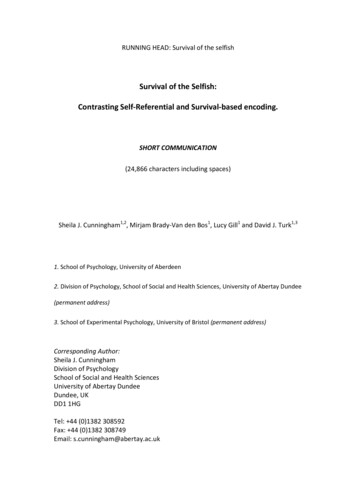




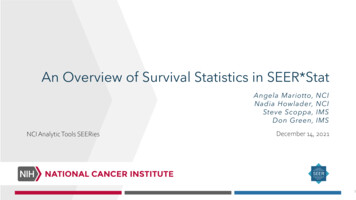

![[ST] Survival Analysis - Stata](/img/33/st.jpg)
